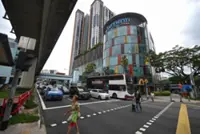An artist's impression of the Jurong Region Line JE2 station. - LTA
SINGAPORE (The Straits Times/Asia News Network): Construction of the Jurong Region Line (JRL) moved up a gear on Friday (Jan 13) after more than three years of preparation works, with the official ground-breaking and launch of the track viaduct in the Tengah area.
Slated to open in three stages from 2027 to 2029, Singapore’s seventh MRT line is projected to have its daily ridership grow from 200,000 in the initial years to more than 500,000 along with the development of the Jurong Innovation District, Tengah Town and Jurong Lake District, said the Land Transport Authority (LTA).
Already a subscriber? Log in
Save 30% OFF The Star Digital Access
Cancel anytime. Ad-free. Unlimited access with perks.





